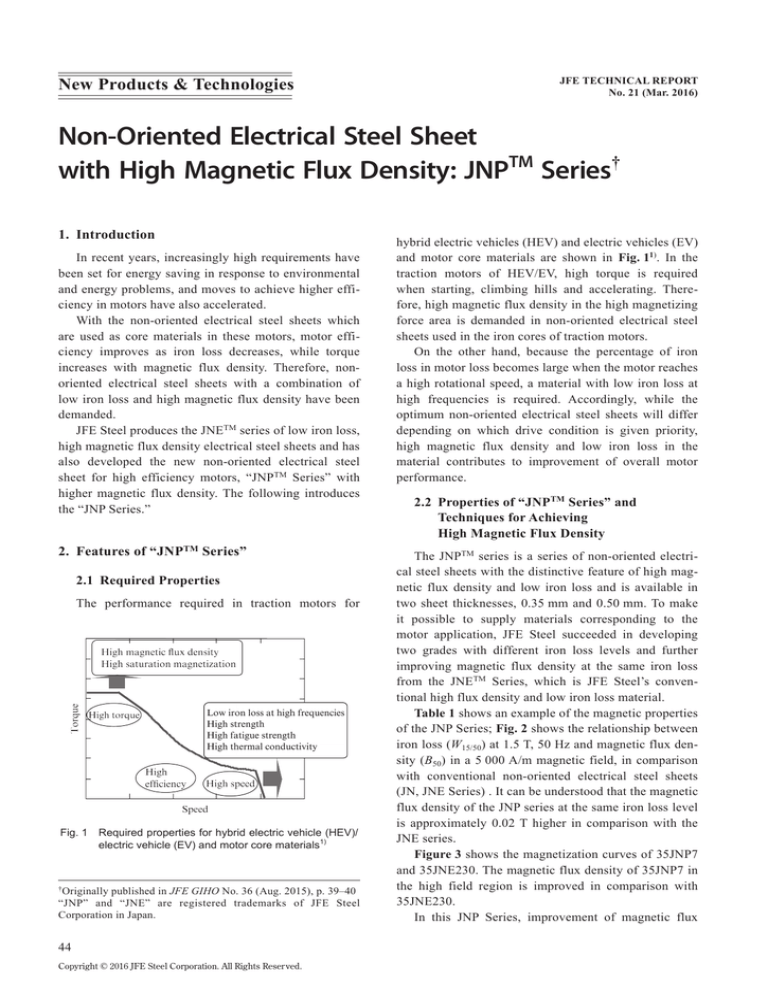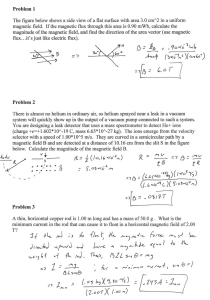
New Products & Technologies
JFE TECHNICAL REPORT
No. 21 (Mar. 2016)
Non-Oriented Electrical Steel Sheet
with High Magnetic Flux Density: JNPTM Series†
1. Introduction
In recent years, increasingly high requirements have
been set for energy saving in response to environmental
and energy problems, and moves to achieve higher efficiency in motors have also accelerated.
With the non-oriented electrical steel sheets which
are used as core materials in these motors, motor efficiency improves as iron loss decreases, while torque
increases with magnetic flux density. Therefore, nonoriented electrical steel sheets with a combination of
low iron loss and high magnetic flux density have been
demanded.
JFE Steel produces the JNETM series of low iron loss,
high magnetic flux density electrical steel sheets and has
also developed the new non-oriented electrical steel
sheet for high efficiency motors, “JNPTM Series” with
higher magnetic flux density. The following introduces
the “JNP Series.”
2. Features of “JNPTM Series”
2.1 Required Properties
The performance required in traction motors for
Fig. 1
Required properties for hybrid electric vehicle (HEV)/
electric vehicle (EV) and motor core materials1)
Originally published in JFE GIHO No. 36 (Aug. 2015), p. 39–40
“JNP” and “JNE” are registered trademarks of JFE Steel
Corporation in Japan.
†
44
Copyright © 2016 JFE Steel Corporation. All Rights Reserved.
hybrid electric vehicles (HEV) and electric vehicles (EV)
and motor core materials are shown in Fig. 11). In the
traction motors of HEV/EV, high torque is required
when starting, climbing hills and accelerating. Therefore, high magnetic flux density in the high magnetizing
force area is demanded in non-oriented electrical steel
sheets used in the iron cores of traction motors.
On the other hand, because the percentage of iron
loss in motor loss becomes large when the motor reaches
a high rotational speed, a material with low iron loss at
high frequencies is required. Accordingly, while the
optimum non-oriented electrical steel sheets will differ
depending on which drive condition is given priority,
high magnetic flux density and low iron loss in the
material contributes to improvement of overall motor
performance.
2.2 Properties of “JNPTM Series” and
Techniques for Achieving High Magnetic Flux Density
The JNPTM series is a series of non-oriented electrical steel sheets with the distinctive feature of high magnetic flux density and low iron loss and is available in
two sheet thicknesses, 0.35 mm and 0.50 mm. To make
it possible to supply materials corresponding to the
motor application, JFE Steel succeeded in developing
two grades with different iron loss levels and further
improving magnetic flux density at the same iron loss
from the JNETM Series, which is JFE Steel’s conventional high flux density and low iron loss material.
Table 1 shows an example of the magnetic properties
of the JNP Series; Fig. 2 shows the relationship between
iron loss (W15/50) at 1.5 T, 50 Hz and magnetic flux density (B50) in a 5 000 A/m magnetic field, in comparison
with conventional non-oriented electrical steel sheets
(JN, JNE Series) . It can be understood that the magnetic
flux density of the JNP series at the same iron loss level
is approximately 0.02 T higher in comparison with the
JNE series.
Figure 3 shows the magnetization curves of 35JNP7
and 35JNE230. The magnetic flux density of 35JNP7 in
the high field region is improved in comparison with
35JNE230.
In this JNP Series, improvement of magnetic flux
Non-Oriented Electrical Steel Sheet with High Magnetic Flux Density: JNP
Table 1 Magnetic properties of JNPTM series2)
Grade
Thickness
(mm)
W15/50
(W/kg)
W10/400
(W/kg)
B50
(T)
35JNP5
35JNP7
0.35
0.35
2.50
2.10
20.0
17.0
1.75
1.70
50JNP5
50JNP7
0.50
0.50
3.00
2.60
32.0
26.0
1.75
1.71
W15/50: Core loss at 1.5 T, 50 Hz
W10/400: Core loss at 1.0 T, 400 Hz
B50: Magnetic flux density at 5 000 A/m
density is achieved by optimizing the addition of alloy
elements and reducing the content of impurities, in combination with texture control by applying a technology
which mitigates the effect of impurities.
The results of a comparison of the recrystallization
textures of 35JNP7 (B 50=1.70 T) and 35JNE230
(B50=1.68 T), which has the same iron loss value, confirmed that the (111) orientation, which has an adverse
effect on magnetic properties, is reduced in 35JNP7.
3. Applications of “JNPTM Series”
The high magnetic flux density and low iron loss
JNPTM Series is not only suitable for the cores of traction motors of HEV/EV, in which high torque is required
in starting, hill-climbing and acceleration, but can also
be applied to induction motors.
Since induction motors use the magnetic field caused
by the induction current which is generated in the secondary conductor of the rotor, without using magnets,
the ratio of copper loss is higher. Therefore, improvement of motor efficiency can be expected by the copper
loss reduction effect due to improved magnetic flux density.
Fig. 2
agnetic properties comparison of JN/JNETM and
M
JNPTM series2)
4. Conclusion
The non-oriented electrical steel sheets of the JNPTM
Series, which possess high magnetic flux density, are
suitable as core materials for the traction motors of
HEV/EV, in which high torque is required, and are also
expected to contribute to high efficiency in induction
motors and brushless direct current (DC) motors for use
in air-conditioner compressors.
References
1) Oda, Y.; Kohno, M.; Honda, A. Journal of Magnetism and Magnetic Materials. 2008, vol. 30, no. 20, p. 2430–2435.
2) Toda, Hiroaki; Oda, Yoshihiko; Kohno, Masaaki; Ishida, Masayoshi; Matsuoka, Saiji. Development of Electrical Steel Sheet JNP
Core for High-efficiency Motor. Materia Japan. 2011, vol. 50,
no. 1, p. 33–35.
For Further Information, Please Contact:
Fig. 3
Magnetization curves of 35JNP7 and 35JNE230
Electrical Steel Business Planning Dept., JFE Steel
Phone: (81) 3–3597-3480 Fax: (81) 3–3597-4779
JFE TECHNICAL REPORT No. 21 (Mar. 2016) Copyright © 2016 JFE Steel Corporation. All Rights Reserved. Unauthorized reproduction prohibited.
45




